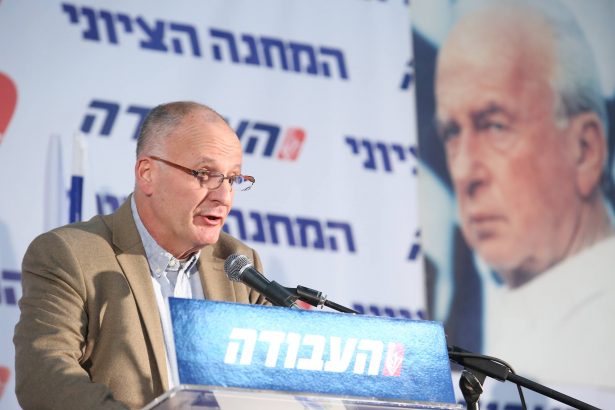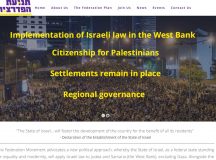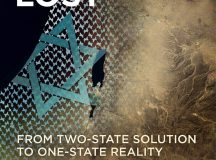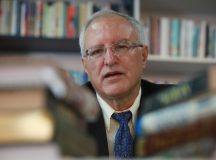Emanuel Shahaf is Co-Chair of the Federation Movement which proposes a federal citizen state in Eretz-Israel/Palestine, excluding the Gaza Strip. He warns here that Israel is drifting into a one state reality and ‘shrinking the occupation’, a strategy proposed by Micah Goodman and endorsed by some in government, will not halt that drift. With even the prestigious INSS think tank now taking the idea of a federative solution seriously he argues that ‘Zionists the world over may soon have to adjust their settings.’
While lip service is paid to the two-state solution in the media and in diplomatic exchanges, reality has clearly taken a different path. This has not yet been widely acknowledged because a paradigmatic change of this magnitude is unlikely to come about without lengthy preparations, or else, a disaster of major proportions. Nevertheless, looking at how things are developing and have been for a while, the picture is becoming increasingly clear.
Israel’s government, despite its remarkably heterogeneous left-right composition, remains hell-bent on continuing construction in the West Bank and East Jerusalem while making absolutely no preparations to separate from the Palestinians. The left part of Israel’s government, the Labour and Meretz parties, are reluctant to apply their limited clout in fear of endangering the government’s stability and until now, play along, albeit occasionally with gnashing teeth. Ra’am, the conservative Islamic Arab list that is part of the coalition, is eager to realise as many gains for Israel’s Arab society as possible and so doesn’t rock the boat over the settlements. The international community, meanwhile, has lost interest in a conflict that both sides, apparently, are loath to try and bring to a mutually agreeable outcome. The US maintains its minimum engagement in order not to lose credibility as a go-between to help resolve the conflict but neither heart nor energy are apparent in the Biden administration’s activities and statements. While under the Obama administration the ‘deal’ was that the US would deliver a decent agreement on Iran while Israel delivered some progress on the Palestinian front, Israel’s present position on the Iran nuclear deal is unlikely to lend itself to US leverage over the Palestinian issue in particular since US has little interest in endangering the stability of the Israeli government coalition.
The Palestinian Authority (PA) meanwhile remains insistent on its maximalist stance and continues to hold a distorted view of its actual bargaining position in this conflict. This while it is slowly degenerating into chaos, being bled dry of resources because of Israel’s refusal to transfer all tax and customs receipts collected for the PA, as long as the latter maintains its support for the families of Palestinian terrorists jailed in Israel (‘Pay for Slay’) at its current level. The same reason prevents the US, which is limited by the Taylor-Force act, from contributing directly to the PA’s coffers. In a twist of reality, at the same time as Israeli government is withholding considerable sums it owes the PA, officials are turning to the donor countries in Europe and the US (those countries that traditionally have been contributing to the PA) begging them to increase their support for the PA before it goes flat broke. Israel is acting as if it has nothing to lose, with the overconfidence of a regional superpower just before reality proves, once again, that it should know better. Adding insult to injury, the Palestinians’ brethren in the Sunni Arab world, to the formers chagrin, are closing deals and forming official diplomatic relations with Israel, disregarding the loud protestations out of Ramallah.
While the background is pretty clear and getting clearer by the week, the foreground is clearer still: ‘The existence of Palestine as a united and separate economic unit is fiction’ says Arye Arnon, Professor Emeritus of Economics at Ben Gurion University in an article on one of Israel’s leading independent news sites. Israel’s economy and that of the West Bank and to some extent Gaza as well, have long become one economic unit, if a bit frayed at the edges. According to Arnon, Israel defies its commitment to the OECD to present its economic country data to reflect that reality.
The Start-Up Nation glitters with economic data that reflect a sleight of hand showing data for two economic entities, Israel and the PA, while in reality the economy is that of one state with one currency, one labour market, one tax collector, one customs office and one regulatory authority. Making 4.5 million residents (out of a total of roughly 14 million) in the single economic unit of Palestine/The Land of Israel disappear from the books, creates a picture of a famously successful global economy with great performance, even in times of a massive international health crisis, in part by bracketing the economy of the Occupied Palestinian Territories (OPT) and its residents. There, low wage workers and low-tech industries are laboring and facilitating Israel’s economic achievements while being kept totally exposed to the ups and downs of economic crisis and without benefiting in any way from the protective social welfare network and support system Israel’s economy has set up for its own citizens and industries.
‘Shrinking the Conflict’
So while this duplicitous game has been going strong for years, primarily for the benefit of Israel and less so, for the benefit of Palestine, Israel is embarking on a new approach to deal with the conflict. From ‘managing the conflict’ under Netanyahu’s decade long regime, Bennett’s government has progressed to ‘shrinking the conflict’. The philosophy behind the new approach is based on the thoughts of author/philosopher Micah Goodman (author of Catch 67) who has clearly caught the drift of Israel’s public sentiment and that of its present government: keep things as they are with minimum effort, don’t rock the boat, but try to improve specifically whatever needs improvement in our interactions with the Palestinians. In short, let’s not resolve the conflict, that is too difficult to contemplate, but let’s minimise it. That, of course, primarily translates into concerns for the economy of Palestine, or rather that of Israel-Palestine, with the thought being that Palestinians who are working and getting paid will be less likely to cause a ruckus, or worse, embark on terror.
Most of the steps taken by Israel to ‘shrink the conflict’ and those contemplated, are indeed in the realm of the economy, either providing more positions for Palestinian workers in Israel, including some in hi-tech companies, building access roads in the West Bank to facilitate transportation, or else helping Palestinian companies to attain standards required to fully and seamlessly interact with the Israeli economy which provides 55 per cent of Palestinian imports and takes in 80 per cent of its exports.
According to a recent report on Israel’s Channel 2 News, the Israeli hi-tech ecology could accommodate another 15,000 employees while the OPT have potentially 30,000 suitable workers, turned out mostly by the 11 Palestinian Universities in the West Bank and Gaza. Meantime between 500 and 1,000 are already employed in hi-tech in Israel proper with the market putting (considerable) pressure on the government to fully open the tap. The sizeable salary gap between Israel and the OPT, one of the last remnants of the ‘one-state but not quite so’ economy, draws Palestinians to work for Israeli companies and improves the economy of the West Bank. Unfortunately, most of the measures taken to shrink the conflict do not specifically help the Palestinian economy to stand on its own but rather further entangle it, for better or worse, depending on who you ask, with that of Israel.
Meanwhile Israeli settlement construction is continuing, always walking a fine line between overdoing it (provoking a clear US veto, as with the recent plan to build 9,000 housing units in the Atarot area on the outskirts of Jerusalem) and building just enough to keep Prime Minister Bennett’s political base happy without catching more than a standard condemnation by the EU, the UN and the US or shaking up the Israeli government.
Developments that are going ahead on the ground include among others, construction in East Jerusalem and ‘DCITY’, an ambitious project combining an amusement park with a large shopping center in an industrial zone on the outskirts of Maaleh Adumim, a community in the West Bank between Jerusalem and the Judean Desert. The DCITY development clearly targets both, Palestinians and Israeli as tenants and customers and according to a recent write-up in the New York Times (25.12.2021) is ‘only the latest illustration of the increasing complexity on the ground, and on the fading prospects of a resolution to the conflict by means of an independent Palestinian state alongside Israel’.
While all the above relentlessly chips away at the viability of the two-state solution and for all intents and purposes have made it extremely unlikely, the political environment both in Israel and Palestine, is playing catch-up. The ghost of the two-state solution is still hovering around somewhere, but it scares no-one anymore and at best is raised occasionally in international fora. Politically in Israel, ‘two states’ are clearly dead, only waiting to be buried by a merciful politician who has the guts. Two thirds of the Knesset object to a Palestinian state and Israeli public support for two states has been below 50 per cent for more than a year. Palestinian public support has been below 40 per cent over the same period. For now, Bennett’s coalition government is too heterogenous to be able to formulate a political alternative to two states while its majority of just one vote it is in no position to deal with the conflict head on.
In consequence, the conflict remains on nobody’s agenda and other than sporadic articles in the media discussing alternatives, mostly various confederation proposals, nothing much is happening. Except, of course, for occasional acts of Palestinian terror and settler violence which both have become more frequent in the last three months, indicative of an extremely fragile status-quo that screams for engagement. For the time being there are no takers among all the main players who prefer to look the other way. Dealing with COVID seems to keep a lot of people busy and appears a valid excuse
The INSS Review of One State and Federative Proposals
As if on command and with exquisite timing, Israel’s preeminent political think tank, the Institute for National Security Studies (INSS), a conservative institution with strong ties to the security establishment, just came out with a review of several one-state scenarios, including proposals for federative arrangements. The review may reflect the recent change of leadership at the Institute where Maj. Gen. (Res.) Amos Yadlin passed the baton to a civilian, former Labor Party MK Prof. Manuel Trachtenberg. While the review, written very carefully by lawyer and Col. (Res.) Pnina Sharvit-Baruch, ignores certain realities and focuses on the pitfalls of one-state scenarios not on their many advantages, it is an important step. It is certainly a milestone to see an integral part of the Israeli establishment, one that has worshipped for decades at the two-state temple, taking one state and federation alternatives seriously for the first time. Of course, the review holds up the two-state state solution as more feasible. It will take more time to fully digest the manifold advantages of federal solutions.
INSS is thus not quite in tune yet with Palestinian leader in exile, Mohammad Dahlan who, as reported by Army Radio correspondent Jacky Chugi in Maariv (24/12/2021) recently suggested to his followers in the Gaza Strip that the two-state solution is dying and Palestinians should seriously contemplate a one-state solution. His suggestion came not too long after PA President Abu Mazen reminded us early October 2021 that Israel’s refusal to adopt two states will force the Palestinians to look for alternatives, like the 1947 UN Partition Plan or one democratic state in historic Palestine with equal civil and political rights for all. While Dahlan’s part of the Fatah faction is still a minority, he does have the support of Hamas ideologue Ahmed Youssef who, embracing Dahlan’s suggestion, claimed that the two-state solution is on its way to getting lost.
These early adopters of one-state scenarios among Palestinian leaders are only following the Palestinian public whose support for the two-state solution, according to tracking polls by PSPCR, has dropped below 40 per cent while support for one-state is going up clocking in already at 37 per cent in 2020.
At the same time a federal forum has been formed in Israel, uniting the three main federation proposals to develop the alternatives and provide a one-stop resource for all things federal in Israel/Palestine, the opposition in Israel’s Knesset has called the current coalition an Israeli-Palestinian government and Mansour Abbas, head of the Islamist Ra’am party which hardly ever mentions anything with regard to Palestine, after announcing publicly that he recognises Israel as a Jewish State and that it will stay one, has just been polled the most popular Arab politician with 47 per cent support among Israel’s Arab public while secular two-stater Ayman Odeh with 25 per cent of the vote, came in a poor second.
Certainly things are changing, and they are changing fast. Realities on the ground will not let this Israeli government off the hook regarding the conflict. With its back to the wall it may find that one or more of the one-state scenarios may well be feasible within the government’s heterogeneity since two states certainly are not. It will be interesting to see how the Israeli public will relate to the change in discourse. Zionists the world over may soon have to adjust their settings.





































This is a very well-articulated, nuanced, and meaningful criticism of the current Knesset, but I think a better analogy to utilize would be to convey that the Palestinian Authority has put the two-state solution into a ‘coma’ and it’s not in Israel’s abilities to do anything unilaterally, but keep the oxygen flowing or pull the plug. The status quo changing is very much contingent on the PA taking genuine measures to invest in coexistence (beginning with an elimination of ‘Pay for Slay’ policy). Otherwise, ‘shrinking the conflict’ is a very gradual, if not futile endeavor.